AMD ATI Radeon HD 4850 Review
AMD ATI Radeon HD 4850
Another cracking bargain from ATI.
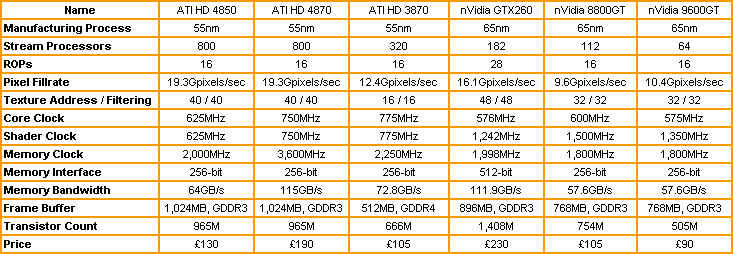
Verdict
You may have gathered over the last couple of weeks that we really like the ATI HD 4870. It isn’t quite the fastest graphics card you can buy – that honour goes to nVidia’s GTX 280 – but it performs very well and comes in at a quite phenomenal price. Still, there are many of us that would balk at the idea of spending nearly £200 on a graphics card, regardless of how fast it is, which is where the ATI HD 4850 comes in.
Like its more expensive sibling, the ATI HD 4850 is based on ATI’s new RV770 chip. In fact, unlike the nVidia GTX 260, which uses the same chip as the GTX 280 but with a few sections disabled, the HD 4850 uses the full extent of RV770. The differences are confined to clock speed and memory configuration. 
So, in essence you still get 800 stream processors, 40 texture address/ filtering units, and 16 ROPs, as well as the 256-bit wide memory interface – although the memory chips themselves are GDDR3 instead of the GDDR5 seen on the HD 4870. However, the core clock speed has been reduced by 17 per cent and memory speed by 45 per cent, which should result in a performance differential that sits somewhere within that percentage range – exactly what the difference will be will differ from game to game.
And that really is it. There’s nothing more to say about the architecture of HD 4850 that hasn’t already been said in our in-depth HD 4870 review. However, when it comes to the card itself there are some significant differences.
Asus and Powercolor were the first board partners to get cards to us for review. Powercolor’s card is running stock clocks while Asus’ is from its T.O.P. range, which means it comes overclocked to 680MHz(core) and 2,100MHz(memory) straight out of the box. This understandably means the Asus card will cost a little more but the choice is there if you want a tad more performance. 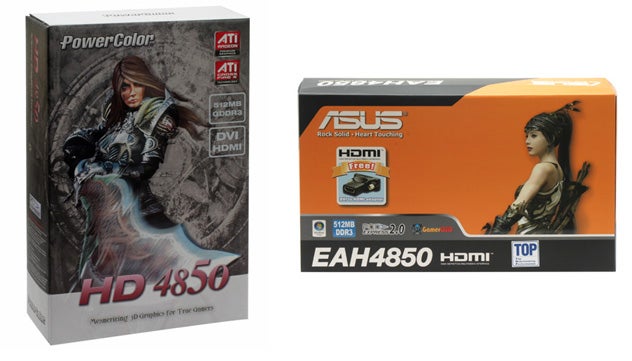
Both cards come with the exact same bundle that includes converters for DVI-to-HDMI, DVI-to-VGA, S-video to composite, and S-video to component as well as a CrossfireX connector. Neither include any free games or other software but considering the approximately £120 asking price this is hardly surprising. 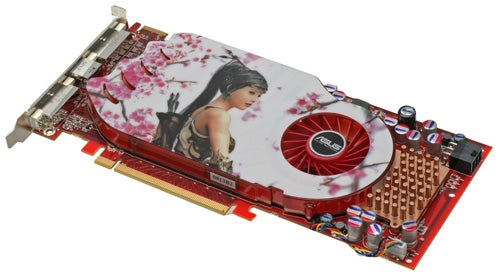
As a result of the cut down clock and memory speeds the cards consume less power and consequently kick out less heat than HD 4870. This means ATI has been able to use a single slot cooler for its reference design, which both cards we’re looking at today have utilised.
While this seems to make sense, ATI obviously never tried to swap out one of these cards after an extended gaming session because, my god, they get hot! Even ATI’s own Overdrive software reports that the cards are running at 80 degrees Celsius and above. Not that we experienced any stability problems, at least with Powercolor’s card. However, the Asus card, which was fine for most of our testing, didn’t fare so well. During Race Driver: GRID testing the card would regularly crash out and we eventually had to abandon testing with the Asus card. I asked an Asus representative about this and he informed us that indeed the reference cooler isn’t sufficient for reliable performance when the card is overclocked so retail versions of the T.O.P. card will use Asus’ Glaciator cooler instead. 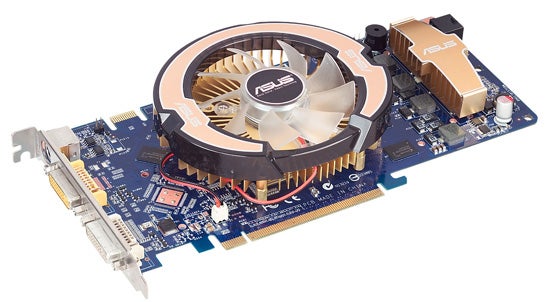
(centre)”’An Asus nVidia 9600GT card utilising the Glaciator cooler”’(/centre)
Now we’ve not seen a card with this cooler before so we can’t vouch for its abilities. However, from what we were told it enables the card to run nearly 20 degrees Celsius cooler than the reference design and, from reading around, the general opinion appears to be that this is also a very quiet and efficient cooler. Of course the obvious problem is that it will make the card semi-dual-slot, i.e. it won’t take up two PCI brackets, so you can still install a USB or audio panel, but you won’t be able to fit another full-size card in alongside. 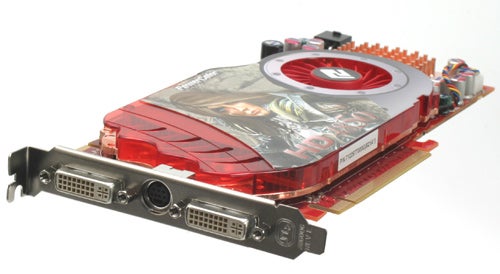
One additional power connector is required to get the card going and this is situated in the normal position on the back edge. Likewise the Crossfire connectors are up top where you’d expect and outputs are the standard two dual-link DVI and combined S-Video/Composite/Component sockets.
All our testing uses a variety of manual run throughs and automated timedemos but regardless of which test method is used we monitor all tests to ensure performance is consistent. Where there are spurious results or dips in performance we will note this. We also do multiple run throughs then take the average of these and report that figure to you. The test setup is as follows:
”’Common System Components”’
* Intel Core 2 Quad QX9770
* Asus P5E3
* 2GB Corsair TWIN3X2048-1333C9 DDR3
* 150GB Western Digital Raptor
* Microsoft Windows Vista Home Premium 32-bit
”’Drivers”’
* ATI: Catalyst 8.4
* nVidia GTX200 Series: Forceware 177.34
* Other nVidia cards: Forceware 175.16
”’Cards Tested”’
* ATI HD 4870
* ATI HD 3870
* nVidia GeForce GTX 280
* nVidia GeForce GTX 260
* nVidia GeForce 9800 GTX
”’Games Tested”’
* Crysis
* Race Driver: GRID
* Enemy Territory: Quake Wars
* Call of Duty 4
* Counter-Strike: Source

While it hasn’t been a huge commercial success and its gameplay is far from revolutionary, the graphical fidelity of Crysis is still second to none and as such it’s still the ultimate test for a graphics card. With masses of dynamic foliage, rolling mountain ranges, bright blue seas, and big explosions, this game has all the eye-candy you could wish for and then some.
We test using the 32-bit version of the game patched to version 1.1 and running in DirectX 10 mode. We use a custom timedemo that’s taken from the first moments at the start of the game, wondering around the beach. Surprisingly, considering its claustrophobic setting and graphically rich environment, we find that any frame rate above 30fps is about sufficient to play this game.
All in-game settings are set to high for our test runs and we test with both 0xAA and 4xAA. Transparency anti-aliasing is also manually turned on through the driver, though this is obviously only enabled when normal AA is being used in-game.
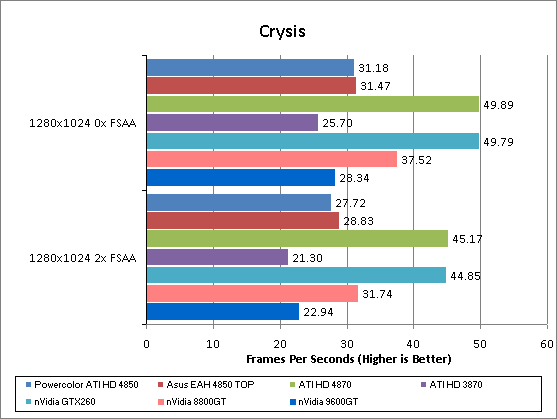
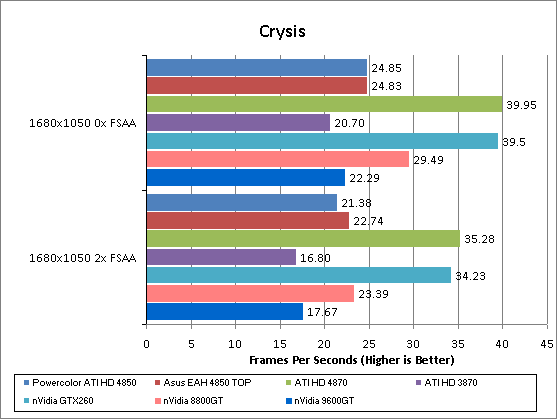
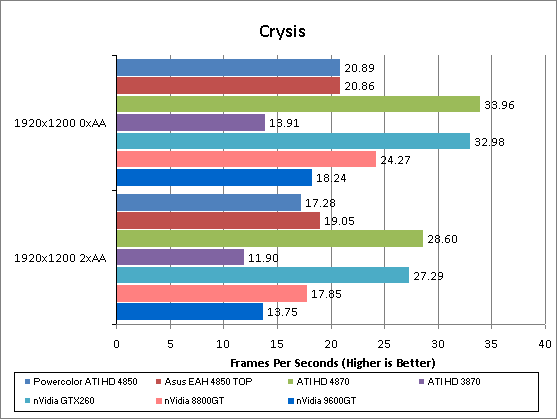
That difference in memory bandwidth obviously has a significant impact on performance as the HD 4850 is markedly slower than the HD 4870. Oddly, though, the overclocking on Asus’ card doesn’t appear to make any significant difference in this title. As for the rest of the competition, the HD 4850 is fighting quite some battle and is currently losing to the nVidia 8800 GT.
Race Driver: GRID is the newest game in our testing arsenal and it’s currently one of our favourites too. Its combination of arcade style thrills and spills with a healthy dose of realism and extras like Flashback makes it a great pickup and go driving game. It’s also visually stunning with beautifully rendered settings, interactive crowds, destructible environments, and stunning lighting. All that and it’s not the most demanding game on hardware, either.
We test using the 32-bit version of the game, which is unpatched and running in DirectX10 mode. FRAPS is used to record frame rates while we manually complete one circuit of the Okutama Grand Circuit, in a Pro Tuned race on normal difficulty. We find a framerate of at least 40fps is required to play this game satisfactorily as significant stutters can ruin your timing and precision. We’d also consider 4xAA as a minimum as the track, barriers, and car bodies suffer considerably from aliasing and are a constant distraction.
All in-game settings are set to their maximum and we test with 0xAA, 4xAA, and 8xAA. Transparency anti-aliasing is also manually turned on through the driver, though this is obviously only enabled when normal AA is being used in-game.
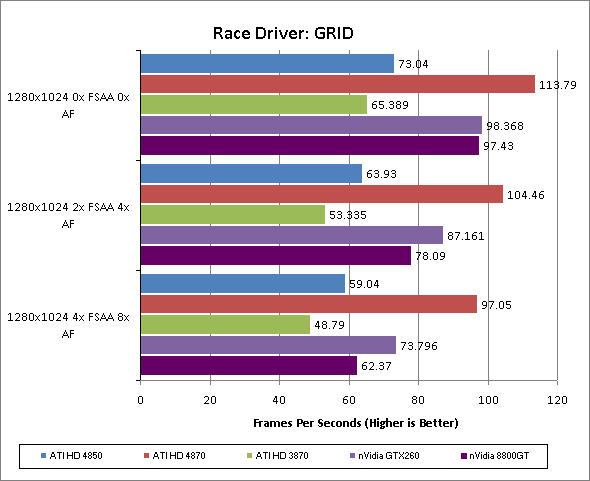
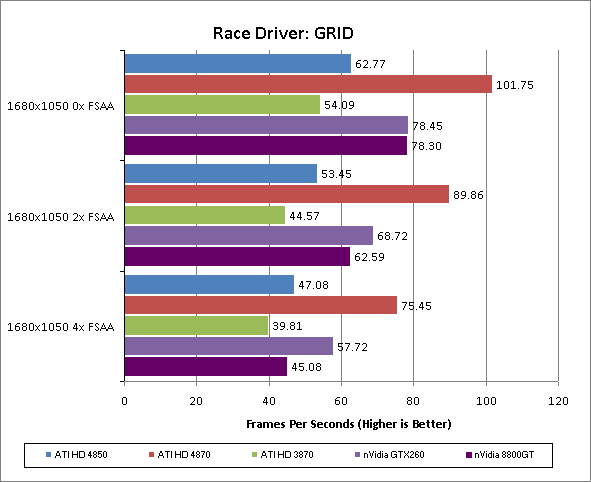
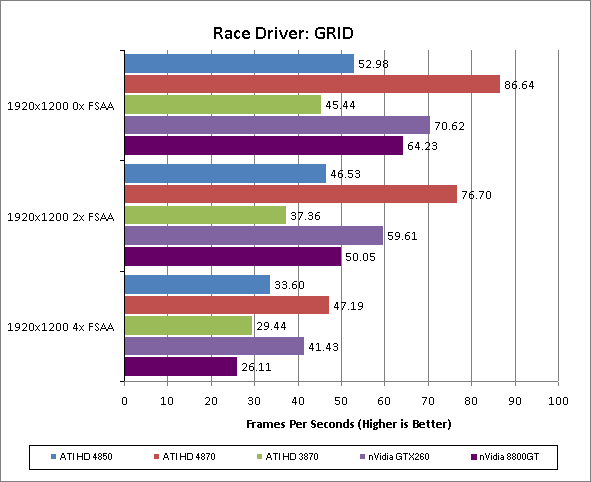
This is perhaps the biggest disappointment for the HD 4850 because we expected it to dominate like the HD 4870 does, but this is far from the case. Indeed it consistently limps in behind the nVidia 8800GT and nVidia GTX 260 in fourth place. Of course, it’s worth remembering we haven’t tested Asus’ overclocked card in this title as it kept crashing. Had that worked we suspect the overclocking would’ve paid dividends. Regardless, though, it’s not like the HD 4850 is unplayable at any of the settings we tested.
Enemy Territory: Quake Wars distinguishes itself from all our other tests by the fact it uses the open source OpenGL API rather than Microsoft’s DirectX. It’s a team-based first person shooter set in a dystopian future war scenario. As a player you get to choose from an enormous range of character types and playing styles, and there’s a whole host of vehicles to choose from too. Battles can span vast areas of open space and involve a huge number of participants. All in all, it’s multiplayer heaven.
We test using the 32-bit version of the game, which is patched to version 1.4. We use a custom timedemo from the Valley level, which we feel is about as graphically intensive as the game gets. We feel a framerate of at least 50fps is required for this game as the intense multiplayer action and high speed mouse movement demands it.
All in-game settings are set to their maximum and we test with 0xAA 0xAF, 2xAA 4xAF, and 4xAA 8xAA. Transparency anti-aliasing is also manually turned on through the driver, though this is obviously only enabled when normal AA is being used in-game.
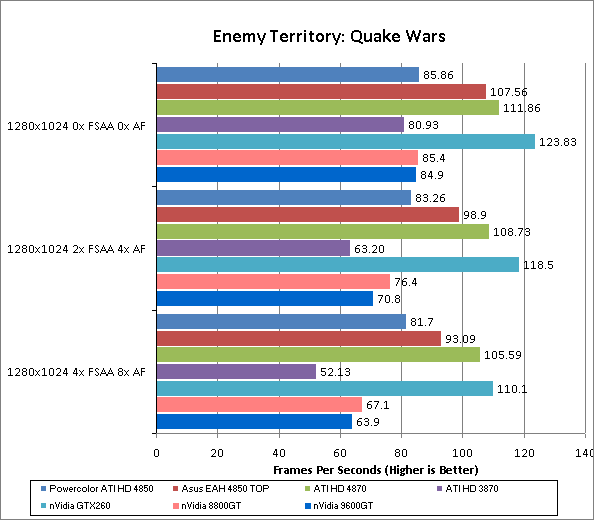
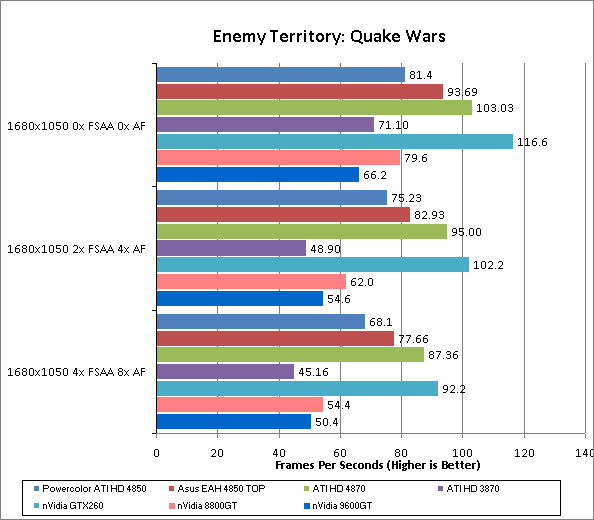
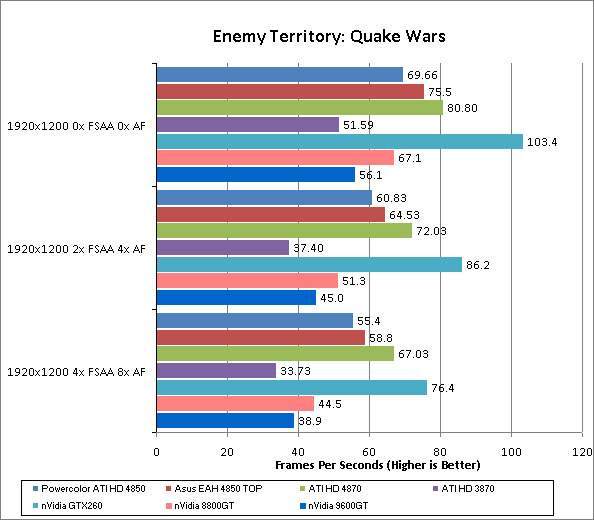
Both ATI’s new cards are soundly beaten by the nVidia GTX 260 in this title but the HD 4850 does at least comfortably beat all its price competitors. Most impressive, though, is the Asus EAH4850 TOP, which is pushing close to HD 4870 performance.
Call of Duty 4 has to be one of our favourite games of last year. It brought the Call of Duty brand bang up to date and proved that first person shooters didn’t need to have the best graphics, or the longest game time. It was just eight hours of pure adrenaline rush that constantly kept you on edge.
We test using the 32-bit version of the game patched to version 1.4 FRAPS is used to record framerates while we manually walk through a short section of the second level of the game. We find a framerate of 30fps is quite sufficient because, although the atmosphere is intense, the gameplay is less so – it doesn’t hang on quick reactions and high-speed movement.
All in-game settings are set to their maximum and we test with 0xAA and 4xAF. Transparency anti-aliasing is also manually turned on through the driver, though this is obviously only enabled when normal AA is being used in-game.
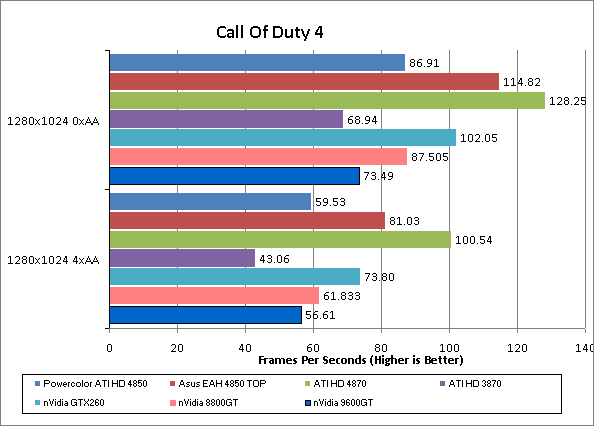
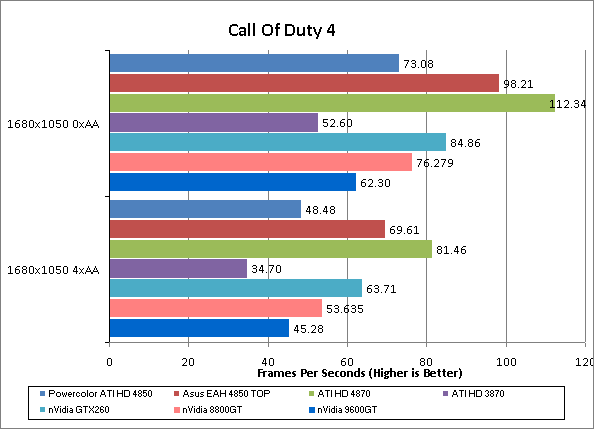
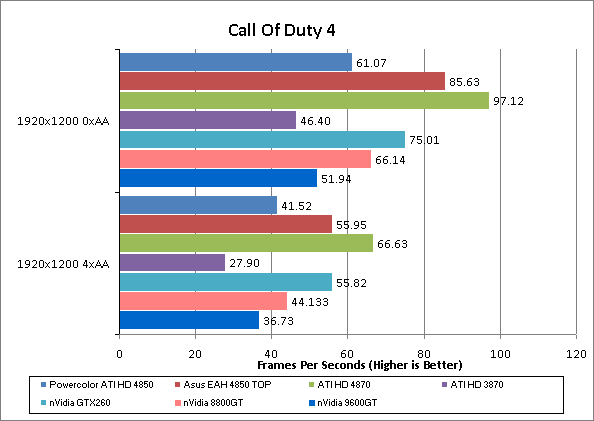
Even though the HD 4850 is again beaten by the GTX 260, it once again puts in a good performance compared to its price competitors and looks like a decent option. This title does again highlight the huge difference in performance between the standard clocked HD 4870 and HD 4850 and the benefits of overclocking the latter.
What can we say about Counter-Strike: Source that hasn’t been said before? It is simply the benchmark for team-based online shooters and, four years after its release, it’s still one of the most popular game in its genre. In complete contrast to Enemy Territory: Quake Wars, it focuses on small environments and incredibly intensive small-scale battles with one-shot kills the order of the day. If you want to test all elements of your first person shooter skills in one go, this is the game to do it.
We test using the 32-bit version of the game using a custom timedemo taken during a game against bots on the cs_militia map. This has a large amount of foliage, so transparency antialiasing has a significant impact on image quality and performance, and is generally one of the most graphically intensive maps available. We find a framerate of at least 60fps is required for serious gaming as this game relies massively on quick, accurate reactions that simply can’t be compromised by dropped frames.
All in-game settings are set to their maximum and we test with 0xAA 0xAF, 2xAA 4xAF, and 4xAA 8xAA. Transparency anti-aliasing is also manually turned on through the driver, though this is obviously only enabled when normal AA is being used in-game.
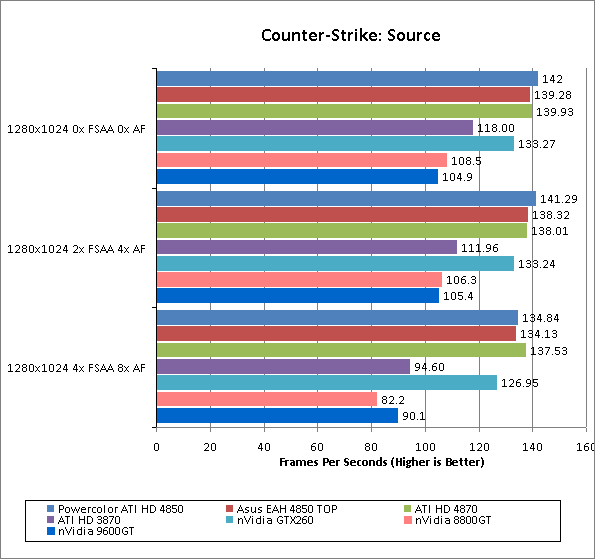
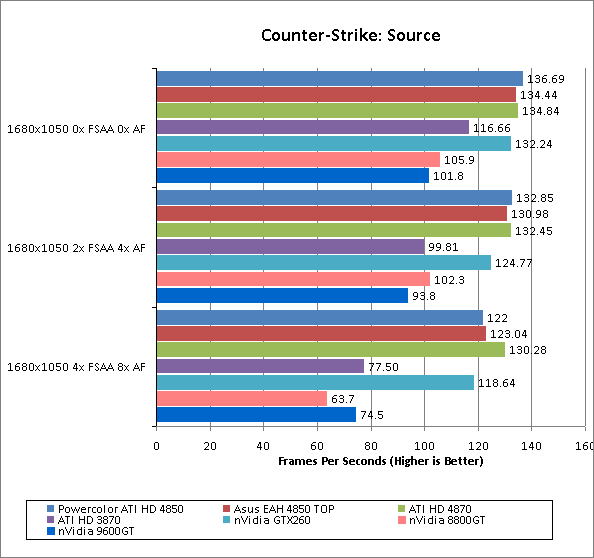
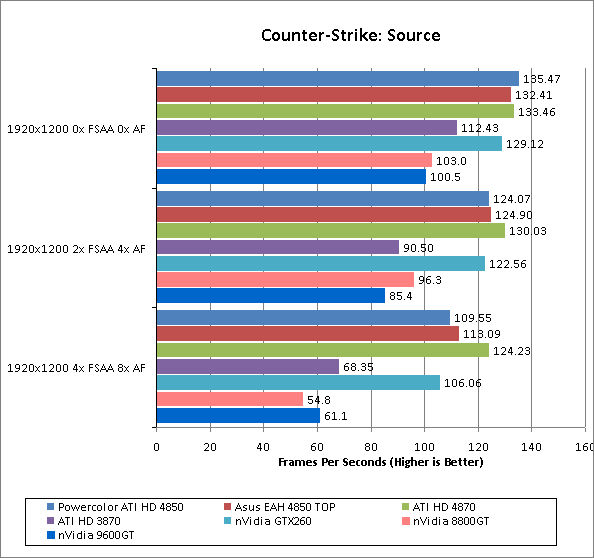
All the cards on test here rattle through this game with consummate ease so there’s little to choose between them. At the maximum settings we tested at, though, the HD 4850, HD 4870 and nVidia GTX 260 all pull away from the crowd. So if you want to game at 1,920 x 1,200 or higher any one of these three cards will be the way to go.
Being as the HD 4850 uses the same chip as the HD 4870, you’d expect it to have roughly the same power consumption figures. However, the change in clock speeds and memory type obviously makes quite a difference as this is the most power efficient card on test when idle and only draws more power than the significantly slower nVidida 9600 GT under load.
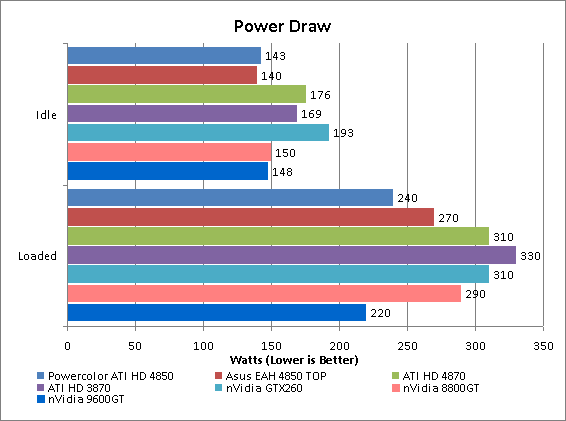
So, if you want a relatively small single slot, power efficient, yet fast graphics card the ATI HD 4850 would certainly seem to fit the bill perfectly. If you then want an extra performance boost, going for an overclocked card certainly seems to pay dividends as well.
We’re still rather concerned with this card’s heat output, though – to the extent that we’d hesitate to recommend it for small form factor cases like Shuttle PCs, which would normally be a natural environment for a single slot card. That said, for more well ventilated cases the heat shouldn’t pose a problem.
One final problem for the HD 4850 is actually the HD 4870. With both nVidia and ATI fighting a fierce price war around the £200 mark, the HD 4850 has been left behind a bit and is now only £50 cheaper than the HD 4870. While that’s still a fair chunk of change, if your motivation for buying the HD 4850 is purely financial (as opposed to wanting the single slot form factor, or lower power consumption) then saving for a few more weeks for the HD 4870 would be a sensible bet because the boost in performance is significant.
”’Verdict”’
The ATI HD 4850 doesn’t quite have the stunning price/performance ratio that earned the HD 4870 an Editors Choice award. However, it is still a very attractive option for those that simply can’t push there budget further. Performance and power consumption are class leading and on every other level its on a par with the competition so all in all it gets a solid Recommended.
Trusted Score
Score in detail
-
Value 9
-
Features 10
-
Performance 7

